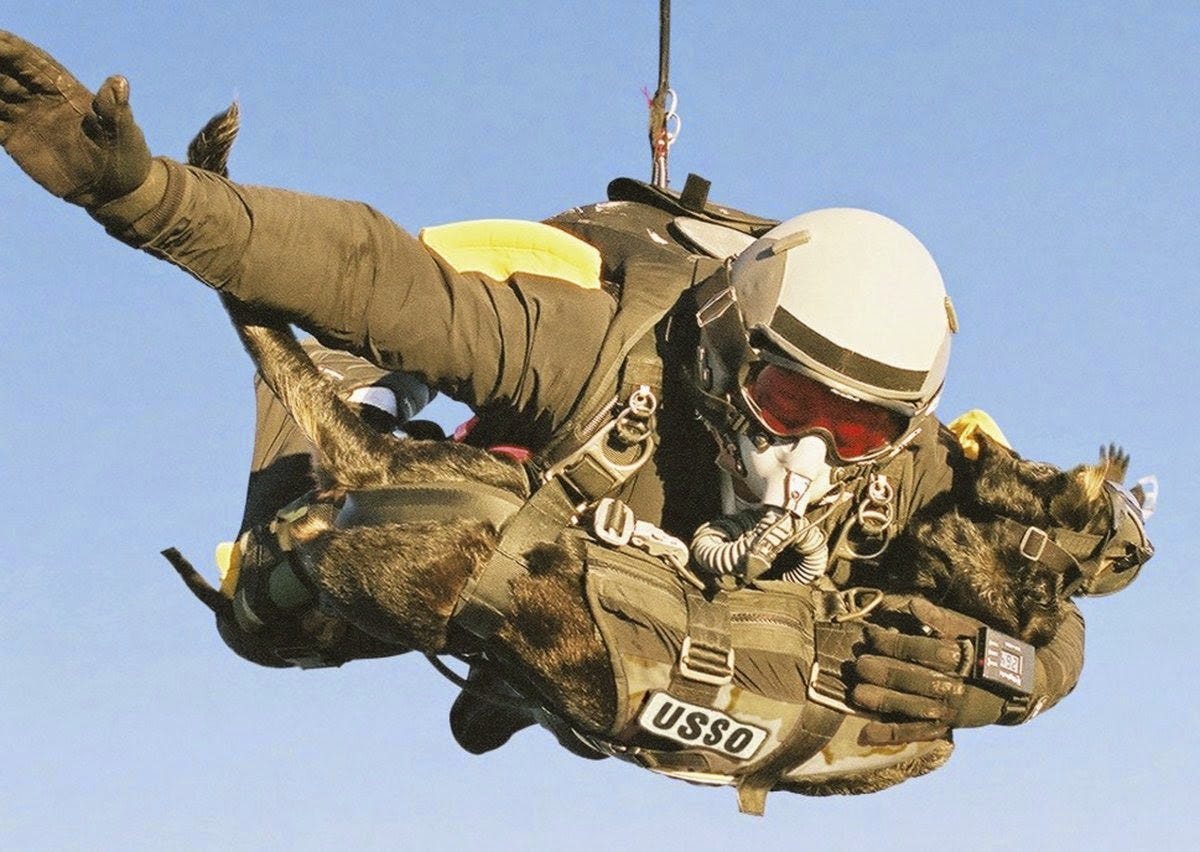
Chute to thrill, tandem-style
Hardwired for camaraderie, dogs have an innate dedication to teamwork that makes them ideal candidates for military service.
Some Navy SEAL dogs are trained parachutists, and the SEAL who trains them to get down (good boy!) from high in the sky is pictured here breaking the world record for man-dog parachute jumps with an altitude of over 30,000 feet.
Seems scary jumping from five miles high, right? But both chute guru Mike Forsythe and pooch Cara are wearing oxygen masks and skin protectors for the big jump.
(All captions: Jefferson Reid)
One giant leap
Dogs usually parachute in tandem with their trainers as seen here, but when properly outfitted with flotation vests, they sometimes make short solo jumps into water on their own.
Vests come with Kevlar D-rings for parachuting and rappelling. The vests are also described as tough enough to withstand attacks from single- and double-edged knives.
The dog who put the bite on Bin Laden
Not every dog gets asked to meet the president, but then again not every dog gets to help bring down Osama bin Laden.
That was Cairo's gig with Navy SEAL Team 6: getting lowered from a MH-60S helicopter into Abottabad, Pakistan, as part of Operation Neptune Spear. It's believed that Cairo wore a vest like this K9 Storm Intruder, said to be able to send encrypted signals through thick concrete and other barriers.
Better bring treats
While taking a victory lap at the White House, Cairo's handler warned the president that if he wanted to meet the dog he'd have to bring treats. He did.
(This Navy dog training on a U.S. base depicts what might happen if you don't have that treat. That is a joke.)
The vest and the brightest
The Canine Tactical Assault Vest pictured above is Kevlar-lined, and is packed with goodies including night vision and infrared cameras, which can be remotely monitored from up to a thousand yards away.
Top-level K9 harnesses cost at least $20,000 and come with mics and speakers, so that humans can, ahem, bark orders via remote.
Stylish shades for form and function
Who is this jaded hipster? Just a standard government issue canine-cool war hero, one of more than 2,700 who serve worldwide as sniffers and special-ops dogs.
Yes, the shades are stylish, but these Dog Goggles, or Doggles as they're called, offer strong eye protection, night-vision and infrared capabilities.
Plus they're cave tested and sandstorm proof.
Copter drop: Dangle dogs
Like their human counterparts, SEAL dogs get extensively trained in sea, air and land attacks (hence the SEAL moniker).
Care (and prosthetics) for small heroes
Though it wasn't always the case, the Department of Defense now pays for all active duty military dogs to fly home, though some who get retired overseas (and those used by military contractors) aren't covered.
A bill in Congress would have remedied this situation but, shocker, they didn't follow through.
Proper breeding, proper breeds
Special demands put on military dogs tend to favor certain breeds with the right mix of strength, smarts and spirit.
High on the list of current attack dog recruits are German shepherds and the slightly stumpier and more muscular Belgian malinois (like the one pictured here), though labradors, dobermans and rottweilers are also often recruited.
Regardless of breed, experts say a typical war dog can save the lives of 150 soldiers over the course of its service.
Tradition of canines in combat
Dogs in combat stretch back at least 3,000 years to ancient Egypt and Greece, and it's easy to see why the Marine pictured here with his canine is part of that tradition.
It's estimated that dogs saved more than 10,000 lives in the Vietnam War alone, and the return from more recent conflicts could be just as profound.
Learning by leaps
For every bit of technological magic these dogs get their paws on, they're also versed in all the basic physical skills needed to get the job done. Case in point: KKowalski—let's call him Killer—working the obstacle course with K-9 handler Master-at-Arms Seaman Sharon Berg at a base kennel in Mayport, Fla.
Berg and Killer work the course several times a day to promote endurance and hone the dog's motor skills.
Beyond the basics in training
Like all newbie recruits, dogs have to endure the hardships of basic training before they specialize and learn how to strap on all the high-tech tools that power elite forces like the Navy SEALs -- whether they walk on two legs or four.
Don't tell anyone, but it looks like this pooch is dogging it on the pushups.
Stand down
Sniffing out improvised explosive devices all day or going on patrol in a war zone can stress out soldiers of any species, which makes a moment of relaxation in the mountains of Afghanistan seem all the sweeter.
Back seat of the Jeep is the chill-zone, yo.
Sniffing out future gigs
Navy dogs hit retirement after 10 years on the job, and they often transition to the same line of work as many humans in the military: law enforcement. With their costly canine training and a nose thousands of times more sensitive than ours, it's not surprising they land gigs as bomb sniffers, trackers and intruder detectors.
But unlike other ex-military types turned cops, we're sure that the dogs know which doughnuts are the freshest.
Ready for retirement
Retired dogs' handlers are given a chance to adopt their pooches stateside. Many do, and the Department of Defense tries to rehabilitate as many as possible in civilian jobs.